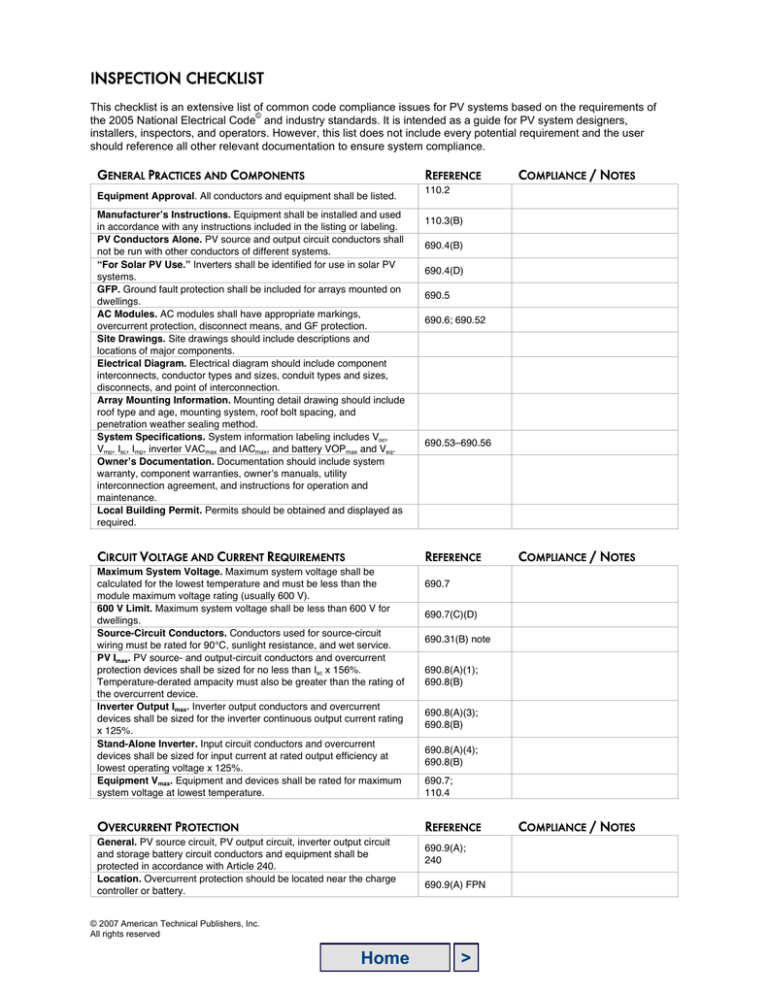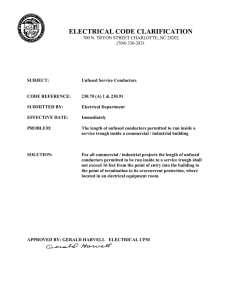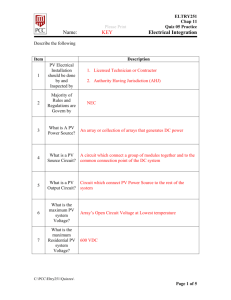
INSPECTION CHECKLIST
This checklist is an extensive list of common code compliance issues for PV systems based on the requirements of
©
the 2005 National Electrical Code and industry standards. It is intended as a guide for PV system designers,
installers, inspectors, and operators. However, this list does not include every potential requirement and the user
should reference all other relevant documentation to ensure system compliance.
GENERAL PRACTICES AND COMPONENTS
REFERENCE
Equipment Approval. All conductors and equipment shall be listed.
Manufacturer’s Instructions. Equipment shall be installed and used
in accordance with any instructions included in the listing or labeling.
PV Conductors Alone. PV source and output circuit conductors shall
not be run with other conductors of different systems.
“For Solar PV Use.” Inverters shall be identified for use in solar PV
systems.
GFP. Ground fault protection shall be included for arrays mounted on
dwellings.
AC Modules. AC modules shall have appropriate markings,
overcurrent protection, disconnect means, and GF protection.
Site Drawings. Site drawings should include descriptions and
locations of major components.
Electrical Diagram. Electrical diagram should include component
interconnects, conductor types and sizes, conduit types and sizes,
disconnects, and point of interconnection.
Array Mounting Information. Mounting detail drawing should include
roof type and age, mounting system, roof bolt spacing, and
penetration weather sealing method.
System Specifications. System information labeling includes Voc,
Vmp, Isc, Imp, inverter VACmax and IACmax, and battery VOPmax and Veq.
Owner’s Documentation. Documentation should include system
warranty, component warranties, owner’s manuals, utility
interconnection agreement, and instructions for operation and
maintenance.
Local Building Permit. Permits should be obtained and displayed as
required.
CIRCUIT VOLTAGE AND CURRENT REQUIREMENTS
110.3(B)
690.4(B)
690.4(D)
690.5
690.6; 690.52
690.53–690.56
REFERENCE
Maximum System Voltage. Maximum system voltage shall be
calculated for the lowest temperature and must be less than the
module maximum voltage rating (usually 600 V).
600 V Limit. Maximum system voltage shall be less than 600 V for
dwellings.
Source-Circuit Conductors. Conductors used for source-circuit
wiring must be rated for 90°C, sunlight resistance, and wet service.
PV Imax. PV source- and output-circuit conductors and overcurrent
protection devices shall be sized for no less than Isc x 156%.
Temperature-derated ampacity must also be greater than the rating of
the overcurrent device.
Inverter Output Imax. Inverter output conductors and overcurrent
devices shall be sized for the inverter continuous output current rating
x 125%.
Stand-Alone Inverter. Input circuit conductors and overcurrent
devices shall be sized for input current at rated output efficiency at
lowest operating voltage x 125%.
Equipment Vmax. Equipment and devices shall be rated for maximum
system voltage at lowest temperature.
OVERCURRENT PROTECTION
690.7(C)(D)
690.31(B) note
690.8(A)(1);
690.8(B)
690.8(A)(3);
690.8(B)
690.8(A)(4);
690.8(B)
690.7;
110.4
690.9(A);
240
690.9(A) FPN
© 2007 American Technical Publishers, Inc.
All rights reserved
Home
COMPLIANCE / NOTES
690.7
REFERENCE
General. PV source circuit, PV output circuit, inverter output circuit
and storage battery circuit conductors and equipment shall be
protected in accordance with Article 240.
Location. Overcurrent protection should be located near the charge
controller or battery.
COMPLIANCE / NOTES
110.2
>
COMPLIANCE / NOTES
Transformers. Overcurrent protection shall be provided for power
transformers in accordance with Article 450.3.
Supplementary Overcurrent Protection. Branch-circuit or
supplementary-type overcurrent devices shall be permitted for PV
source circuits, but shall be no greater than the series fuse on module
listing.
Listed for DC. Overcurrent devices shall be listed for use in DC
circuits and shall have the appropriate voltage, current, and
interrupting ratings.
Multiwire Branch Circuits. No multiwire branch circuits are allowed
on 120 V inverter output circuit or panels.
Fuses. Locations of fuses shall be identified. Fuses shall be rated for
Isc x 156%.
Bypass Diodes. Locations of bypass diodes shall be identified.
Diodes shall be rated for Isc x 156%.
DISCONNECT MEANS
690.9(B)
690.9(C);
110.3(B);
UL1703
690.9(D)
690.10(C)
690.9(A);
690.8(B)
690.8(B)
REFERENCE
DC Disconnect. Disconnect means shall be provided between
photovoltaic power system output and other building conductors, no
disconnect in grounded conductor.
Accessibility. Photovoltaic disconnecting means shall be installed at
a readily accessible location either outside of a building or structure or
inside nearest the point of entrance of the system conductors (not in
bathrooms).
Marking. Each photovoltaic system disconnect means shall be
marked, suitable for use, no more than six grouped disconnects for PV
system.
AC Disconnect. Disconnect means shall be provided for inverters,
batteries, charge controllers, and the like, from all ungrounded
conductors of all sources.
Bi-fed Fuses. Disconnecting means shall be provided to
independently disconnect a fuse from all sources of supply if the fuse
is energized from both directions.
Features. Switches or circuit breakers shall be provided to disconnect
ungrounded conductors, are readily accessible, have on/off indication,
and have appropriate interrupt rating.
690.13(A)
690.14(C)
690.14(C)
690.15
690.16
690.17
Disconnects energized in open position must be labeled as such.
690.17
Roof DC Disconnect vs Conduit. Where PV source circuits are run
inside a building, they shall be in metallic raceways from the point of
penetration into the building to first accessible disconnect.
690.31E;
690.14(C)(1)
CONDUCTORS AND WIRING METHODS
REFERENCE
Wiring Connections. Wiring connectors shall be listed for the
intended use and environment. Screw terminals shall be tightened to
the recommended torque. Crimp-on terminals shall be used with listed
crimping tool.
Wiring Methods. Standard and appropriate wiring methods shall be
used. Wet-rated conductors should be used in conduits in exposed
locations.
Color Codes. Grounded conductors shall be white or gray and
grounding conductors shall be green, green/yellow, or bare.
Strain Relief. Strain relief or conduit shall be used on all conductors.
Insulation Types. Single conductor cables type SE, UF, USE, and
USE-2 single-conductor are permitted in PV source circuits. If exposed
to sun, sunlight-resistant cable must be used.
Flexible Conductors. Tracking or movable array mounts shall use
flexible conductors identified for hard service and outdoor use.
Small Conductors. Single-conductor cables in sizes 16 AWG and 18
AWG shall be permitted for module interconnections when such
cables meet the ampacity requirements of 690.8.
Module Connectors. Module connectors shall be polarized,
noninterchangeable, guarded, locking, and have “first to make / last to
break” contact for grounded conductor.
110.14
300;
690.31(A)
400.22
300.4;
400.10
690.31(B)
690.31(C);
400.3
690.31(D);
310.15
690.33
© 2007 American Technical Publishers, Inc.
All rights reserved
<
Home
COMPLIANCE / NOTES
>
COMPLIANCE / NOTES
Junction Boxes. Junction boxes shall be used for conductor
connections and to protect live parts. Boxes shall be of appropriate
type for application, accessible, and appropriate size.
690.34;
300.15;
370
GROUNDING
REFERENCE
DC Grounding. One DC conductor shall be grounded for two-wire PV
systems operating above 50 V. DC grounding shall be made at any
single point on the PV output circuit.
Ungrounded Systems. Ungrounded systems must have overcurrent
protection in each of the ungrounded conductors.
Equipment Grounding. All non-current-carrying metal components
shall be grounded in all PV systems, including module frames,
equipment, conduit, and boxes as applicable.
Grounding Electrode. AC and DC grounding electrode conductors
may be connected to same ground electrode system.
DC Grounding Electrode Conductor. The size of the ground
electrode conductor for a DC system shall be no smaller than #8 AWG
copper or #6 aluminum, no smaller than neutral or largest conductor,
and no larger than #6 AWG copper or #4 aluminum.
690.41;
690.42;
250.4(A)
240.20;
240.21
MAKINGS AND LABELS
REFERENCE
Modules. PV modules shall be labeled with UL listing, series fuse
requirement, Voc, Vmax, Isc, Imax, Pmax.
DC Disconnect. PV power source shall be labeled with Voc, Vmax, Imax,
and Isc at the DC disconnect.
AC Disconnect. Point of interconnection shall be labeled with inverter
Vmax and Imax at AC disconnect.
Batteries. Batteries shall be labeled with Vop, Vmax, Veq, and polarity.
Stand-Alone Systems. Exterior visible notice shall indicate the
presence of a stand-alone system and the location and means of
disconnection.
Plaque at Utility Meter. If PV and utility service disconnects are not
located together, service disconnect shall have a label indicating the
locations of the PV disconnects.
Backfed Circuit Breaker. Circuit breakers backfed from an inverter
shall be marked as an additional power source.
690.43
690.47(C)
250.166
690.53
690.54
690.55
690.56(A)
690.56(B)
690.64(B)(5)
REFERENCE
Listed Inverters. Inverters shall be listed and identified for interactive
operation.
Islanding. Interactive inverters shall de-energize when utility power
source is lost.
Supply-Side Interconnection. Disconnecting means and overcurrent
device shall be provided for a supply-side interconnection.
Load-Side Interconnection. Load side interconnections shall be
made at dedicated branch circuit or fusible disconnect.
Busbar Ratings. Ampere ratings of all breakers feeding panel shall
not exceed busbar rating (or 120% of busbar rating for dwellings).
GFCI. Interconnection shall be on the line side of any ground-fault
protection equipment.
Marking. Overcurrent devices supplying power to busbar shall be
marked to indicate the presence of all sources of power.
690.60;
UL1741
BATTERIES AND CHARGE CONTROL
REFERENCE
General. Installation shall use appropriate racks, trays, and means of
ventilation.
480.8;
480.9;
480.10
Home
COMPLIANCE / NOTES
690.61
690.64(A)
690.64(B)(1)
690.64(B)(2)
690.64(B)(3)
690.64(B)(4)
690.71(B)
480.99(B), (C)
690.71(C)
© 2007 American Technical Publishers, Inc.
All rights reserved
<
COMPLIANCE / NOTES
690.51
UTILITY INTERCONNECTION
Dwelling Voltage Limit. Operating voltage of battery systems for
dwellings shall be less than 50 V nominal.
Access. Battery terminals and other live parts shall be guarded and
adequate working space shall be provided.
Fuses. Current-limiting fuses (types RK-5, RK-1, T) shall be installed
on battery output circuits.
COMPLIANCE / NOTES
>
COMPLIANCE / NOTES
Cases and Racks. Nonconductive cases are required for batteries
greater than 48 V nominal. Conductive racks must be at least 6" from
top of battery case.
Series Disconnects. Series disconnects shall be provided for battery
strings over 48 V nominal.
Maintenance Disconnect. A disconnect shall be provided for the
grounded conductor of each string for battery systems over 48 V,
accessible only to qualified persons.
Charge Control. Battery charge control shall be used in any system
where charge rates are greater than 3% of battery capacity.
Diversion Charge Controller. Diversion charge controllers shall have
a secondary, independent means for charge control. DC diversion
loads, conductors, and overcurrent devices must be rated for at least
150% of the controller current rating.
Temperature Probes. Temperature compensation probes for
inverters and charge controllers should be attached to the side of a
battery or between batteries.
Battery Wiring. Battery interconnections should be made with #2/0
AWG and larger flexible cables. Such cables shall be listed for hardservice use and identified as moisture-resistant.
© 2007 American Technical Publishers, Inc.
All rights reserved
<
Home
690.71(D)
690.71(E)
690.71(F)
690.72(A)
690.72(B)
NABCEP Study
Guide
690.74
400





